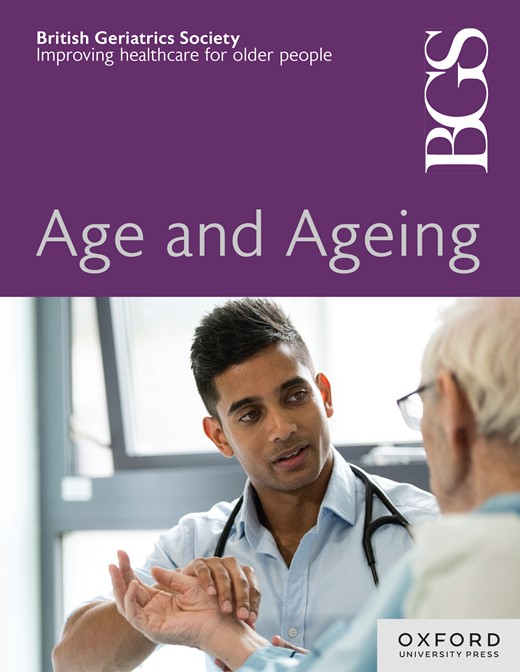老年人血液生物标志物和虚弱的性别和系统特异性分析——老年人的活动和功能研究
IF 7.1
2区 医学
Q1 GERIATRICS & GERONTOLOGY
引用次数: 0
摘要
脆弱背后的潜在病理生理机制尚不完全清楚。目的评价35种血液生物标志物与虚弱的性别和系统特异性关联。方法采用2009年3月至2010年4月收集的基于人群的老年人活动和功能研究(≥65岁)的基线数据。虚弱通过虚弱指数(FI)来定义。分析了与脆弱相关的生物标志物的性别和器官/系统特异性。在广义线性模型(GLM)中使用反向选择对二分类FI (FI≥0.2体弱)的连续和逻辑回归(LR)建立虚弱模型,调整年龄、教育程度、吸烟和饮酒,并在需要时进一步调整药物。估计残差均方误差(RMSE)、曲线下面积(AUC)、敏感性、特异性、阳性预测值和阴性预测值(PPV、NPV)。结果在1180名参与者中(男性占57.9%),GLMs总体上与γ -谷氨酰转移酶、高密度脂蛋白-、低密度脂蛋白-胆固醇和生长分化因子15,以及男性性别特异性转铁蛋白、丙氨酸转氨酶、睾酮、维生素D、乳酸脱氢酶、NT-proBNP (RMSE 0.064,特异性0.96,NPV 0.86)和女性白细胞、胱抑素C、DHEA、fT3、hs-cTnT (RSME 0.074,特异性0.94,NPV 0.87)的数据吻合良好。LR模型包含较少具有相似特性的生物标志物(男性AUC 0.83,特异性0.80,NPV 0.93;女性AUC 0.85,特异性0.72,NPV 0.94)。结论获得的模型提供了与脆弱相关的性别特异性差异的见解。令人惊讶的是,当考虑到所有其他生物标志物时,炎症并没有发挥重要作用。获得的模型为鉴定血液生物标志物提供了一个良好的框架,用于脆弱预测模型。本文章由计算机程序翻译,如有差异,请以英文原文为准。
Sex- and system-specific analysis of blood-based biomarkers and frailty in older adults—the Activity and Function of the Elderly study
Background Underlying pathophysiological mechanisms behind frailty are not fully understood. Objective To evaluate the sex- and system-specific association of 35 blood-based biomarkers with frailty. Method Baseline data from the population-based Activity and Function of the Elderly study (≥65 years), collected between March 2009 and April 2010, was used. Frailty was defined through a frailty index (FI). Biomarkers associations with frailty were analysed sex-, and organ−/system-specific. Frailty models were built using backwards selection in Generalized Linear Models (GLM) for continuous and logistic regression (LR) for dichotomized FI (FI ≥0·2 frail), adjusting for age, education, smoking and alcohol intake, with further adjustment for medications when needed. Residual mean squared error (RMSE), area under the curve (AUC), sensitivity, specificity, positive and negative predictive value (PPV, NPV) were estimated. Results Among 1180 participants (57·9% men) GLMs showed a good fit of the data with gamma-glutamyl transferase, high-density lipoprotein–, low-density lipoprotein–cholesterol and growth differentiation factor 15 overall, and sex-specific transferrin, alanine transaminase, testosterone, vitamin D, lactate dehydrogenase, NT-proBNP in men (RMSE 0·064, specificity 0·96, NPV 0·86), and leucocytes, cystatin C, DHEA, fT3, hs-cTnT in women (RSME 0·074, specificity 0·94, NPV 0·87). LR models included less biomarkers with similar properties (AUC 0·83, specificity 0·80, 0·93 NPV in men; AUC 0·85, specificity 0·72, NPV 0·94 in women). Conclusion Obtained models provide insight into sex-specific differences related to frailty. Surprisingly, inflammation does not play an important role when taking all other biomarkers into account. Obtained models offer a good framework for the identification of blood-based biomarkers to be used in frailty prediction models.
求助全文
通过发布文献求助,成功后即可免费获取论文全文。
去求助
来源期刊

Age and ageing
医学-老年医学
CiteScore
9.20
自引率
6.00%
发文量
796
审稿时长
4-8 weeks
期刊介绍:
Age and Ageing is an international journal publishing refereed original articles and commissioned reviews on geriatric medicine and gerontology. Its range includes research on ageing and clinical, epidemiological, and psychological aspects of later life.
 求助内容:
求助内容: 应助结果提醒方式:
应助结果提醒方式:


